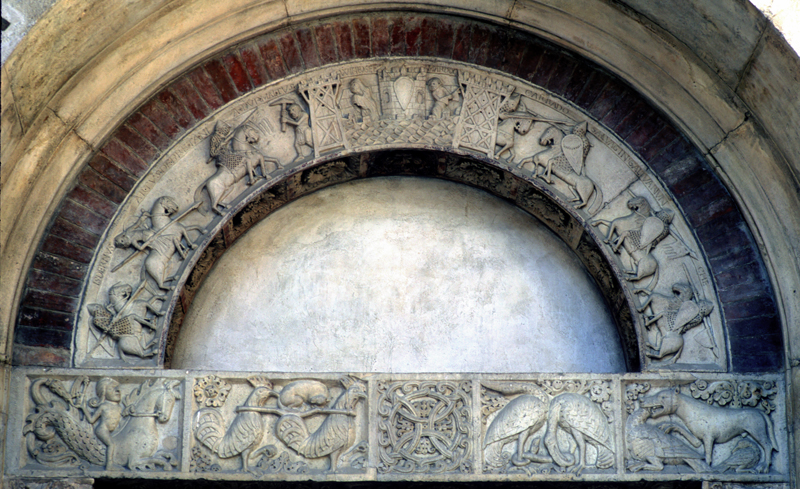Modena is a historic city located in the Emilia-Romagna region of northern Italy, north of Bologna.
The construction of Modena Cathedral, or Duomo di Modena, commenced in the early eleventh century. The cathedral was commissioned by Duke Matilda of Tuscany (Matilde di Canossa), a prominent figure in the region. The cathedral was consecrated in 1184, marking the completion of its construction. It served as the religious center of the city and the seat of the archbishop of Modena.
On the west facade of the cathedral, above the central portal, is the Modena Archivolt Sculpture – considered to be one of the most important and iconic works of Romanesque art in Europe. The archivolt dates back to the twelfth century and is a semicircular archway, richly decorated with intricate relief sculptures.
The Porta della Pescheria, meaning “Fish-market Gate,” is dated around 1120-1140. In this arch there are scenes of Queen Guenevere held captive by Meliagrant, and King Arthur and his knights riding up to the castle to rescue her. In the scenes there are characters not known of anywhere else, whether in art or literature.

From left to right is the following figures carved:
- A knight
- Isdernus (Lancelot)
- Arthus Britani (King Arthur)
- A castle with Burmaldus, Winlogee (Guenevere), Mardoc (Meliagrant), and Carrado (Carados).
- Calvariun (Galeshin?)
- Che (Kay)
- Galvaginus (Gawain)
The theories differ amongst scholars, for example: King Arthur should be Yder; Isdernus is not Lancelot but Yder; this is not Arthurian characters or events depicted, but something else.
Modena | 0 to 800 AD
Roman Origins | 1st century BC – 5th century AD
Modena, known as Mutina during Roman times, was founded as a Roman colony in the second century BC. It was situated along the ancient Roman road known as Via Aemilia, connecting the cities of Rimini and Piacenza. Mutina was strategically located and served as an important administrative, commercial, and military center within the Roman province of Cisalpine Gaul.
Fall of the Western Roman Empire | 5th century AD
In the early fifth century, the Western Roman Empire faced invasions and pressures from various Germanic and barbarian tribes. In 402 AD, Mutina was sacked by the Visigoths under King Alaric, part of the larger series of sackings that culminated in the sack of Rome in 410 AD. In the following decades, the city saw further turmoil and changes in leadership due to the ongoing instability in the Western Roman Empire.
Lombard Rule | 6th century AD
The Lombards, a Germanic tribe, began their conquest of northern Italy in the late sixth century. Modena fell under Lombard rule, and the city became part of the Lombard Kingdom of Italy. The Lombards had a lasting impact on the region’s culture and governance, including the establishment of duchies.
Frankish Rule | 8th century AD
In the eighth century, during the reign of Charlemagne, king of the Franks and later Emperor of the Carolingian Empire, Modena and its surrounding region came under Frankish rule, which marked the beginning of Frankish influence in the area.
Image Credit
Modena Archivolt | Robert Aho
